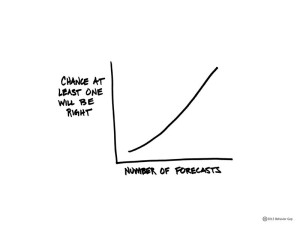 I got my start in financial services as a broker in the age of Gordon Gecko and the “Greed is Good” mentality. Although I did have a monogrammed shirt and suspenders back in the day, I did not find a lot of the advice that was passed on to us as brokers especially helpful for clients. It certainly wasn’t selfless, that’s for sure.
I got my start in financial services as a broker in the age of Gordon Gecko and the “Greed is Good” mentality. Although I did have a monogrammed shirt and suspenders back in the day, I did not find a lot of the advice that was passed on to us as brokers especially helpful for clients. It certainly wasn’t selfless, that’s for sure.
A lot has changed since those days, but one piece of advice that I got at the very beginning of my career has stuck with me to this day. The advice was that my life and my level of success in life would reflect my clients’.
I’ve noticed that over the years, this has become pretty true, although ultimately it’s a bit of a “Chicken or the Egg” question.
But, it does make me realize that many of the same financial decisions my wife and I are facing are probably the same financial issues that many of you are facing. One of the nagging questions that we’re faced with all of the time is the need to balance a bit of on-hand emergency cash with the need to continue to put money away into various longer term investment strategies and tax free or tax deferred options (IRAs etc.), or preferably both.
The idea that I want to stash cash into a tax deferred growth environment is appealing, but if I put too much in and need to pull cash for an emergency, I’ve shot myself in the foot. If I leave it in savings or our checking account for very long, I shoot myself in the other foot: Keeping balances in cash that you don’t ever use is very expensive over the long term, both in the erosion of it’s purchasing power and the opportunity cost versus investing it.
I’ve come across a couple of ideas that seem to offer the best of both worlds: The ability to stash possible excess cash in tax advantaged accounts AND the ability to access it should an emergency arise.
Roth IRAs
It’s easy to turn your nose up at a Roth IRA because the contributions are not tax deductible. Many CPAs don’t think to routinely recommend them to their clients because they are typically having conversations during tax time and clients are seeking ways to lower their tax bills now, not later.
The basics of Roth IRAs are that you can put money into them and the money will grow TAX FREE if you wait to access it until you’re 59 1/2. Roths differ from regular IRAs because in a regular IRA you have to pay taxes on the money you pull from it (after 59 1/2) as if it were ordinary income and you must start withdrawals from your IRA at 70 1/2 and you NEVER have to withdraw money from your Roth IRA if you don’t want to.
But, here’s the “cash-stash” secret… Most people don’t know that you can withdraw up to the amount you contributed to your Roth without a penalty and without paying income taxes on it. This brings the anxiety level about having adequate emergency reserves way down if you use a Roth IRA as a cash stash. Why not grow the money long term, tax free, think positively and anticipate that you won’t need it?
Here’s another “cash-stash” secret about Roth IRAs: These things are GREAT for retired folks who are still generating income or whose investments or mandatory IRA withdrawals provide in excess of what they need for living expenses: You can continue to contribute to a Roth IRA forever and you never have to pull it out. Pull the money you’re required to pull out of your IRA and stash it in your Roth. Bam.
There are income limits and annual contribution limits. I’ve summarized and simplified the details, but you can find the details at http://www.irs.gov/Retirement-Plans/Roth-IRAs or you can call me and we’ll make an appointment to go through the details together and investigate how it relates to your situation.
Health Savings Accounts (HSAs)
Chances are that you’re not hearing about HSAs from your other advisors or your accountant. I think that’s because there’s no real vested interest for anyone to help you set up one of these accounts. In most cases, these accounts are set up at your local bank. Some have some investment options available, some do not.
But, if you make the assumption that medical bills (either now, or most likely later) will eat up at least some of your savings, you might as well save it in the right “bucket” and for many this can be an HSA. Contributions (up to $6,550 for couples this year and $3,300 for singles) are pre-tax. Money grows tax-sheltered, and withdrawals for medical expenses are tax-free.
Your health plan has to be a high-deductible plan and in most situations, this is at least $2,500 for families and $1,250 for singles, to be eligible. The average deductible on a typical employer-sponsored plan is now at $1,850 for families, so more and more of you are qualifying.
Here’s the “cash-stash” secret: You don’t have to use your HSA for medical bills if you don’t want to or don’t need to. You can use it as an additional retirement funding tool because once you are eligible for Medicare at 65, the purpose behind your HSA goes away and the government disallows further contributions. Although you can still use it for the rest of your life to cover medical expenses, you can also use it to fund your retirement lifestyle. You have to pay taxes on distributions just like a regular IRA, but there is no penalty and no required minimum distribution at 70 1/2. Neat.
Here’s another secret: You can fund your HSA from your traditional or Roth IRA if you want to. Let’s say you have some medical expenses and you don’t have an HSA yet and you don’t have the cash on hand because you stashed a bunch in your Roth. What to do?
You are allowed a tax-free funding withdrawal from your IRA to an HSA. You can only do this once in your life and you can only do it up to the amount that you could contribute to your HSA annually. But, this can significantly reduce “cash-stash” anxiety by knowing you have another option if you get caught short-handed on emergency cash.
There are all kinds of rules that need further clarification if you’re to consider this… but on balance it’s definitely worth your time. I’ve summarized and simplified the details and you can find the link to the IRS details about all of the rules at http://www.irs.gov/publications/p969/ar02.html#en_US_2014_publink1000204020 or you can call me and we’ll make an appointment to go through the details together and investigate how it relates to your situation.
I hope you’ve found these tips helpful. Here’s the link to get a peek at my availability and schedule a quick phone call: https://www.timetrade.com/book/VNTL6
Have a great holiday weekend,
Jeff




 Many people dream about what they would do all day if they didn’t have to go to work. The key is to
Many people dream about what they would do all day if they didn’t have to go to work. The key is to 






